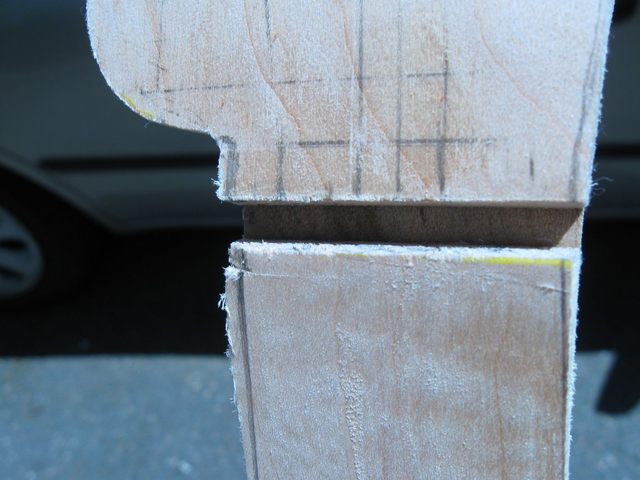
Now that the neck has been fitted to the gourd it is appropriate to finish the detailing of the neck. There are some problems to fix, and some details to finish. One of the problems is this nick that I took out of the finger board with the saw back when I was shaping the neck.
You can see it there on the left side of the neck right next to the nut slot. There is enough width left on the neck that I can get rid of some of this problem by narrowing the neck by the nut. I have drawn some lines on the neck where I will trim it. I also have to finish the carving of the handstop, which was left flat.
The flat spot in the photo will be hollowed out to make a nice transition from the peghead to the neck.
Another problem is some tearout on the peghead at the hole for the second string.
The tearout is on the front surface of the peghead, so it will be visible when the neck is done. I don't know what to do with this other than to cut down the wood until it is gone. That will make the peghead overlay a bit thin, but I don't see anything else I can do.
The first thing I did was to sharpen my french curve scraper so that I can use it to hollow out the handstop. I flattened the edge in a hone.
I put it into the vise and smoothed it out with a diamond file.
Finally, I drew the hook on the edge using the burnisher. This scraper works the same way as the other scraper, its just that the edge is curved.
Speaking of the other scraper, I used my card scraper to take off that wood up by the nut. It works well for removing controlled amounts of wood in tight places.
On to the handstop. I hollowed out the side facing the peghead to provide a gradual transition from the peghead to the neck. Here is my small gouge again.
I can push the corner of the sandpaper into to the hollow to smooth out the wood in there.
The curved scraper is also useful for getting a nice curved shape inside the hollow.
One thing I want to check out before I continue is the flatness of the finger board. I failed to do that on one of my previous banjo necks and had to take off the finish to fix it.
I got out the jack plane and put an edge on it. Then I planed the finger board until the plane was taking off wood evenly from the board. This also takes off some of the thickness of the finger board to remove the nick up by the nut.
After the plane, I got out the cabinet scraper to put a smooth surface on the wood.
That ought to do it. I got out the yardstick to see if the neck is flat. I placed the yardstick on the neck and looked for light under it.
Looks like there is a bit of relief in the neck. That is better than having backbow, which will make the strings buzz. Here is what is left of the nick that I had up at the nut.
That is it for today. I spent 3 1/2 hours doing this work. The weather was beautiful, and I spent most of it outdoors.
Original post date July 8, 2009